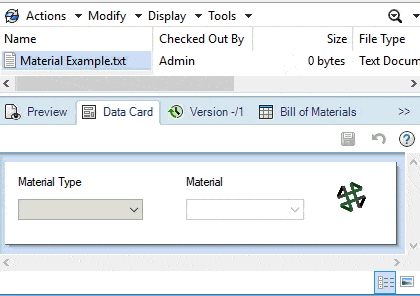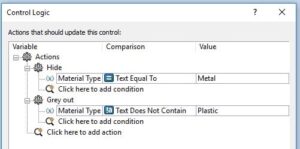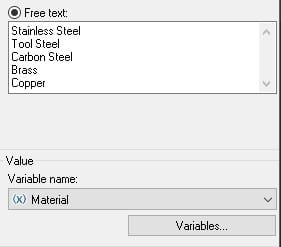Filtered Droplists in PDM Standard
Here is a screen shot from my SOLIDWORKS PDM Standard data card.

When the user chooses his material type as “metal” his material droplist is filtered to show only metals, if he chooses plastics, his droplist is filtered to only show plastics. This is something rather simple to do with SOLIDWORKS PDM Pro, but this is PDM Standard! Can you guess why type of amazing sorcery is going here?
You are actually looking at a combobox droplist [for material type] and two different combobox dropdowns for material.
The “Material Type” droplist connects to the variable “Material Type”. This list has two selections: “Metal” and “Plastic”.
For the material selection, there are actually two controls on top of each other, both pointing to the same “Material” variable. Control logic is used to determine which control the user sees.
First, I add the dropdown that will be used if the user assigns the material type to be “plastic”. (The control has to be a dropdown, you cannot use a droplist.) Connect it to a variable named material. This is the control logic I am using:


The plastic control will be visible as long as the material type is not “metal”. Thus, if material type is “plastic” or “blank”, this will be the control the user will see. If the control is not “plastic”, the control will be grayed out. Now when the data card is first opened, the material will be gray and the user will have to pick a material type before he can choose a material.
Next create a second dropdown, make it exactly the same size as the plastic dropdown and place it on top of the plastic dropdown. The control logic here is a bit simpler:


This dropdown will only be visible if the user chooses the material type to be “metal”, otherwise the control will be hidden.
Only one control is visible at a time because of the control logic. Both controls are connected to the same “material” variable, that is why it is important to use a dropdown. If you would have chosen a droplist, the hidden control would not be able to accept a choice not on its list, and that would make it impossible for PDM to store the variable value’s correctly.
This is a rather simple example where we only had two choices for the first category, but does scale up. You simply need to add a dropdown for each category -the control logic is nearly the same. If you find you are doing a lot of these, PDM Pro does this much simpler with dynamically controlled lists. You only need one dropdown/droplist! If you want even more in PDM Pro, PigeonHole is a fantastic tool to use where the logic gets very complex.
Two final tips. Fully define the first dropdown first, then make a copy of it. All of the control logic copies with the control. Secondly don’t stack the controls on top of each other right away. Make sure the logic is working perfectly first because once the controls are on top of each other it is harder to make individual edits to each control.

 Blog
Blog